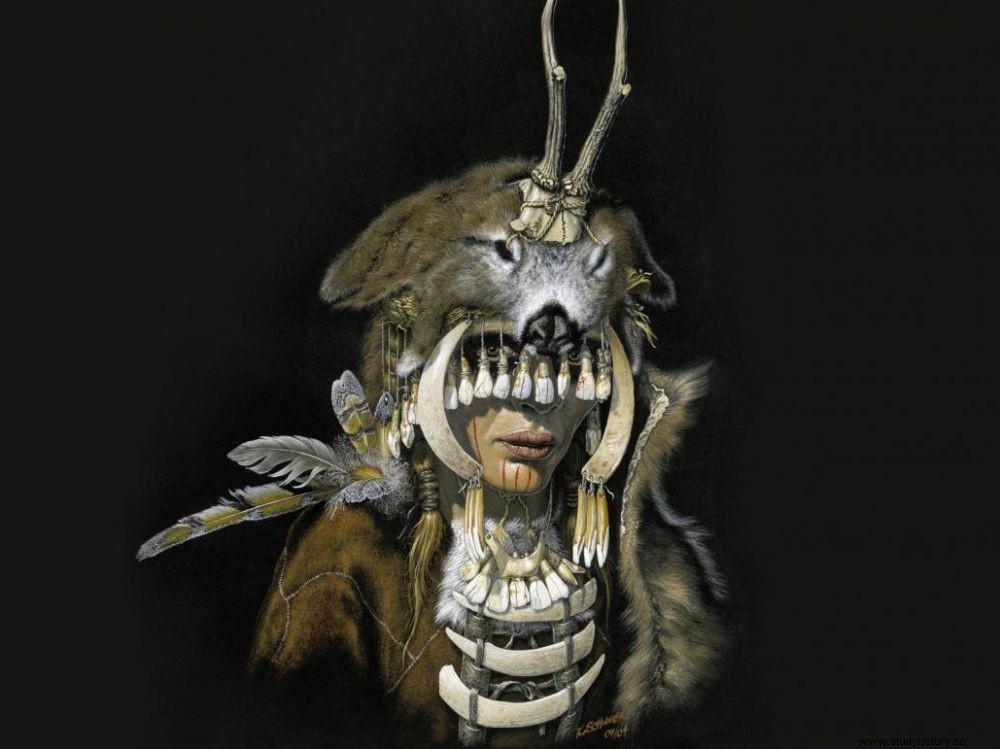8500 years old, the "Shaman of Bad Dürrenberg" is one of the most exceptional Mesolithic burials encountered in Europe. Discovered in Germany at the beginning of the 20 e century, new studies carried out on his burial place have just revealed the ultimate secret...

Artistic rendition of the "Shaman of Bad Dürrenberg" by Karol Schauer. Exclusive use Sciences et Avenir . Reproduction forbidden.
"We had a hard time believing what we were looking at" , confesses to Sciences et Avenir, Susanne Friederich, of the State Office for Archeology and Monument Preservation, from her laboratory at the Halle Museum, in Saxony-Anhalt (Germany). A few months ago, the researcher and her team returned between August and December 2020 to study the remains of an exceptional tomb discovered in 1934, in the town of Bad Dürrenberg and considered to be one of the most famous graves. of the Mesolithic, a pivotal period situated between the end of the Paleolithic and the Neolithic (see box ). And there, they made a fascinating discovery:the "Shaman of Bad Dürrenberg", who died 8500 years ago and is known for the impressive amount of objects with which she had been found, had also been buried... with a deer elaphe!
A mysterious deer present in the tomb
Eighty-five years after the skeleton was expressly exhumed in 1934 – due to work for a horticultural fair – the researchers returned to re-examine the scene. This time, they carried out a rigorous examination of the embankments and the rest of the burial pit, which enabled them to recover small fragments of bone material. Adjoining the burial, they also discovered to their amazement what had completely escaped the excavators of 1934 (who had only had 24 hours to operate):namely the remains of an animal. "We immediately halted our work so that these remains, and anything associated with them, could be studied with the utmost care", continues Susanne Friederich. The entire excavation has thus been put in boxes for a subsequent study in the laboratory, which could take several months. It may help to understand the reason for the presence of this deer, which remains to this day without example.
 Some of the objects found in 1934 in the burial of the "Shaman of Bad Dürrenberg". © Erika Hunold, Landesamt für Denkmalpflege und Archäologie Sachsen-Anhalt. For Sciences et Avenir/photo reproduction prohibited.
Some of the objects found in 1934 in the burial of the "Shaman of Bad Dürrenberg". © Erika Hunold, Landesamt für Denkmalpflege und Archäologie Sachsen-Anhalt. For Sciences et Avenir/photo reproduction prohibited.
Just like the richness of this burial for the time considered. At the beginning of the 20th century, the funerary pit had indeed been found entirely lined with red ochre, and even constituted a double burial. The "shaman", a woman aged 25 to 35, was buried in a seated position, a young child of 4 to 6 months placed between her legs. His body had been found buried under an incredible accumulation of objects, ranging from about thirty flint arrowheads preserved in a long crane bone used as a case, to a hundred bone remains of red deer, about fifty pendants teeth of aurochs, steppe bison, roe deer, wild boar, beaver and 65 freshwater turtle shell fragments! Several kinds of bivalves including mussels and pearl oyster shells were also part of the offerings.
"We had a hard time believing what we were looking at" , admits to Sciences et Avenir , Susanne Friederich, of the State Office for Archeology and Monument Preservation, from her laboratory at the Halle Museum, in Saxony-Anhalt (Germany). A few months ago, the researcher and her team returned between August and December 2020 to study the remains of an exceptional tomb discovered in 1934, in the town of Bad Dürrenberg and considered to be one of the most famous graves. of the Mesolithic, a pivotal period located between the end of the Paleolithic and the Neolithic (read box below ). And there, they made a fascinating discovery:the "Shaman of Bad Dürrenberg", who died 8500 years ago and is known for the impressive amount of objects with which she had been found, had also been buried... with a deer elaphe!
A mysterious deer present in the tomb
Eighty-five years after the skeleton was expressly exhumed in 1934 – due to work for a horticultural fair – the researchers returned to re-examine the scene. This time, they carried out a rigorous examination of the embankments and the rest of the burial pit, which enabled them to recover small fragments of bone material. Adjoining the burial, they also discovered to their amazement what had completely escaped the excavators of 1934 (who had only had 24 hours to operate):namely the remains of an animal. "We immediately halted our work so that these remains, and anything associated with them, could be studied with the utmost care", continues Susanne Friederich. The entire excavation has thus been put in boxes for a subsequent study in the laboratory, which could take several months. It may help to understand the reason for the presence of this deer, which remains to this day without example.

Some of the objects found in 1934 in the tomb of the "Shaman of Bad Dürrenberg". © Erika Hunold, Landesamt für Denkmalpflege und Archäologie Sachsen-Anhalt. For Sciences et Avenir/photo reproduction prohibited.
Just like the richness of this burial for the time considered. At the beginning of the 20 e century, the funerary pit had indeed been found entirely lined with red ochre, and even constituted a double burial. The "shaman", a woman aged 25 to 35, was buried in a seated position, a young child of 4 to 6 months placed between her legs. His body had been found buried under an incredible accumulation of objects, ranging from about thirty flint arrowheads preserved in a long crane bone used as a case, to a hundred bone remains of red deer, about fifty pendants teeth of aurochs, steppe bison, roe deer, wild boar, beaver and 65 fragments of freshwater turtle shells! Several kinds of bivalves including mussels and pearl oyster shells were also part of the offerings. Pierced animal teeth had been used as necklaces or as clothing ornaments. A polished ax made of a river pebble as well as two fragments of deer skulls with their antlers, accompanied the whole. On her right wrist, the young woman also wore a bracelet alternating with small stones, fish vertebrae, turquoise, a feline claw and delicate shells. In addition to the richness of this burial, it is above all an anthropological anomaly published in 2006 in the International Journal of Osteoarchaeology which has led specialists to believe that this extraordinary tomb could have been that of a shaman.

Presentation of the Mesolithic burial of Bad Dürrenberg, in the permanent exhibition of the Museum of Halle, Saxony-Anhalt (Germany). © Juraj Liptak, Landesamt für Denkmalpflege und Archäologie Sachsen-Anhalt. For Sciences et Avenir/photo reproduction prohibited.
A shamanic hypothesis established on the basis of anatomical examinations
Striking analogies have indeed been found between his reconstituted panoply and those, for example, of the costumes worn by the Tongouse shamans of Siberia. The young woman was mainly the carrier of anatomical anomalies at the level of the posterior arc of the atlas – the first cervical vertebra – and that of the foramen magnum, the large hole drilled in the occipital bone. These could have been the cause of various neuropathological symptoms that could lead to "abnormal" behavior. More specifically, and according to experts, they could have led to involuntary loss of movement control (ataxia) leading to a kind of trance. This could have resulted in this woman being singled out within her community and given powers or a particular social position. Still according to specialists, these behaviors could, in those very ancient times, have been interpreted as possession by spirits. The causes of death of this young woman have in any case been attributed to a serious infection in her upper jaw, as revealed by anatomical examinations.

Crates of the recent discoveries made at the burial place of the "Shaman of Bad Dürrenberg" for an archaeological excavation in the laboratory. © Johanna Kleinecke / Landesamt für Denkmalpflege und Archäologie Sachsen-Anhalt
If the burial of Bad Dürrenberg remains an exceptional case, the recent discovery of the deer has led to the programming of new archaeological excavations, which will begin as soon as the Covid-19 pandemic ends. These could deliver other surprises.
The European Mesolithic
About 8000 years ago, following a sudden global warming that began about 2000 years earlier, the retreat of Scandinavian and Alpine glaciers and the rise in sea level completely changed the European landscape. Over time, the tundra became covered with vast forests:dense vegetation of pines, hazel trees, and large oak groves appeared, populated in particular by deer and wild boar. The Mesolithic –"which is in the middle"– constitutes this pivotal period, located between the end of the Paleolithic and the Neolithic, during which the "shaman" of Bad Dürrenberg lived.
